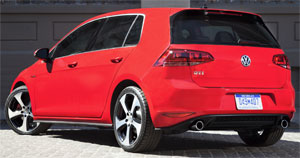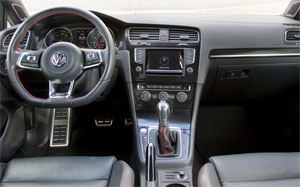This year marks the 40th anniversary of the Volkswagen Golf, the most popular VW of all time. While we knew it as the Rabbit back in 1974, like the rest of the world, we grew up to love these compact two and four-door hatchbacks for their combination tidy looks, oodles of interior space, and no-nonsense driving enjoyment. And what better way to celebrate then with an all-new Golf. So, happy anniversary to us!
We didn’t expect a big physical change for the 2015 Volkswagen Golf. So, we weren’t disappointed to find that the 7th generation only improves on Golf’s basic formula that, while slightly larger, is still “so right” even after four decades.
While all powertrains are more efficient, even the base TSI Golf with a 1.8-liter turbo I4 feels peppy and very refined. Ratings are 170-horsepower and 200 lb-ft. of torque. And the top-line GTI comes in at 210-horsepower and 258 lb-ft. of torque with a 2.0-liter inline-4 turbo.
A late arriving Performance Package holds peak torque longer and boost horsepower to 220. The Performance Package also includes a torque sensing, electronically controlled limited-slip differential, a first for a front drive car. It can transfer up to 100% of torque to either front wheel to help eliminate both torque steer and understeer.
 A 5-speed manual is standard in the TSI, with an optional 6-speed automatic. TDIs and GTIs can be fitted with a 6-speed manual or DSG gearbox.
A 5-speed manual is standard in the TSI, with an optional 6-speed automatic. TDIs and GTIs can be fitted with a 6-speed manual or DSG gearbox.
There’s even a very well done new eGolf. It’s super quiet even for an EV, and has some of the best feeling EV brakes. Range is EV typical at 70-90 miles.
But, during our early San Francisco drive time, we focused on the hot-hatch GTI, as it is the first model to the market, and along with a Golf Sportwagon due next year, is a key to growing Golf sales in America.
Yes fans, that means the GTI is going more mainstream. Both two and four-door hatchback bodies strike us as less visually distinctive than the previous GTI. Even the rear spoiler is subtle. Stance is noticeably improved, however, as the Golf’s new front-wheel-drive MQB chassis is stretched in every dimension.
Having been on sale in Europe for over a year, U.S. buyers had to wait for Golf production to start over here down Mexico way.
But drivers should not notice that transatlantic transformation, as the new GTI has all of its spirit plus a new level of sophistication. There’s a slightly heavier German feel; very solid, almost like driving a small bank vault around. It’s a more agile yet nailed down car than the Jetta.
Even without the Performance Package, all GTI’s sport VW’s updated XDS traction system that monitors suspension load to help contain understeer. Standard too is selectable drive mode with Normal, Sport, and Individual settings.
Even in Normal, the GTI corners great and feels nice and compact, and while steering feel is not all there, it’s better than the Audi A3 that uses the same chassis.
 The GTI’s interior was already a step above most of its competition, and it still outshines them with improved material quality and simplicity. GTI highlights include color stitching, paddle shifters for the DSG, and a sweet flat-bottom steering wheel.
The GTI’s interior was already a step above most of its competition, and it still outshines them with improved material quality and simplicity. GTI highlights include color stitching, paddle shifters for the DSG, and a sweet flat-bottom steering wheel.
All trim levels have touch screen audio and connectivity, with similar controls to the rest of the VW lineup, only the screen is now larger. A backup camera is oddly not standard, while Forward Collision Alert and Park Distance Control are also options. GTI convenience upgrades include Fender Premium audio, automatic climate, and pushbutton start.
The new Golf adds to its already plentiful rear seat space, while low load floor cargo room now rivals many mid-size cars with station wagon-like versatility.
Government Fuel Economy Ratings for a GTI with an automatic are 22-City, 33-Highway, and 28-Combined; an overall gain of one. That makes for a good Energy Impact Score of 11.8-barrels of annual oil use with 5.3-tons of CO2 emitted.
More features for less money is always a good recipe for success, as a base GTI 2-door hatchback begins at $25,215. The story is even better for the TSI with a sticker drop to $18,815, both partially due to a new entry level S-trim.
Except for the new electronic diff, the 2015 Volkswagen Golf projects little wow factor. Rather, it adheres to a “more of the same but better” approach. Still, we are wowed that VW can build such an affordable small car that is rock solid and totally entertaining to drive. And that makes the 40th anniversary of the Golf a milestone we’ll not forget.
Specifications
- Engine: 1.8-liter/ 2.0-liter
- Horsepower: 170/ 210
- Torque: 200 lb-ft./ 258 lb-ft.
- EPA: 22 mpg city/ 33 mpg highway
- Energy Impact: 11.8 barrels of oil/yr
- CO2 Emissions: 5.3 tons/yr
Long Term Updates
Mileage: 6,082Well, that was fast…after a short 3 months, and enjoyable 6082 miles, our Volkswagen GTI is rolling off the MotorWeek lot. Our SE 4-door hatch was well equipped, with back up camera, leather seats, and a quick revving 210 horse 2.0-liter with slick shifting 6 speed DSG transmission.
Final fuel economy was 28.7 miles per gallon. That beats the gov’s Combined Rating of 28, but keep in mind it does require premium.
A small price to pay, though, for the sheer fun that the GTI brought to everyone on the staff. Plus with generous cargo space, it’s just a great all-around car.
Now, if we don’t sound too torn up over losing the GTI so quickly, it’s because another one is taking its place!
This 4-door, base GTI drops the backup cam and leather seats, but gains a third petal. That’s right, a proper 6 speed manual trans is how we roll now. Fuel economy jumps one, but we think the fun factor will go up much more over the next 90 days.
Mileage: 1,000Does the weather cooling down have you feeling down? Not us! We’re pumped up from taking delivery of this 2015 Volkswagen GTI for our Long Term test fleet!
The 7th gen GTI already won us over during our initial test, and we just had to have more!
The 2.0 liter turbo inline four only puts out 210 horsepower; but with the GTI’s lightweight design and spot-on setup, that’s plenty. Through just over 1,000 “break-in” miles, we’re seeing an average of 30.9 miles-per-gallon, already above the government combined rating of 28.
Our GTI came well equipped in 4-door mid-level SE trim; with added features like Fender premium audio, a power sunroof, leather seating, and backup camera, among others. The optional Lighting package brings Bi-Xenon headlights and LED runners, while the Driver Assistance Package adds front and rear proximity alerts, and Forward Collision Warning.
All that, plus 52.7 cu. ft of cargo room makes it a great staff support vehicle.
Easy to drive; even easier to live with- that was our first take away from the all-new GTI. So we’ll see if some extended seat time keeps that feeling alive.
Mileage: 2,340With just 2,340 miles added to the odometer, we’re still in the honeymoon phase with our 2015 Volkswagen GTI.
So naturally, we’re still in love with just how fun and easy it is to drive. Even a quick trip to lunch can be entertaining. More often than not, our staffers keep it in “Sport” mode, which tightens steering nicely.
But like any relationship, we’re discovering a few flaws as well. Nothing that’s a deal breaker, just minor annoyances. Some with longer legs are getting bruised knees from the steering column protruding too far into the driver knee area. And the requirement for premium fuel has fooled a few of us, who’ve put in regular grade, and noticed some engine sputtering and delayed throttle response as a result.
Fuel economy gets no complaints from us at all, as we’re averaging just over 35 miles per gallon after some long highway commutes and work-related road trips. We don’t expect the numbers to stay this high from the 210 horsepower turbo I4 and 6 speed DSG transmission, though, especially as fall turns into winter.
Mileage: 6,000“Row, row, row your gears…” That’s what’s been going through our heads driving our long term Volkswagen GTI.
The 210 horsepower turbo 4 and 6 speed manual combo still charms us. As we’ve finally thawed out from our winter freeze, the GTI has too. And it’s no worse for wear, as we’ve had no mechanical issues.
After 6,000 miles, fuel economy has settled to 28.1 miles per gallon of Premium, right on its Combined government rating.
For $26,000, you’d be hard pressed to find a car that delivers this much fun, functionality, finesse and funk. The GTI does it all, without being pretentious. And that’s the way we like to roll.
Mileage: 4,000A six speed manual is where it’s really at, right?! And we’ve found our first 4000 miles in the 2015 Volkswagen GTI S to be a perfect cure for the winter blues.
Call it “Easy Rider”, as this base model 4-door hatchback provides an effortless driving experience from the 210 horsepower turbo 4 and slick shifting manual combo. Great bolstered seats and a solid chassis up the fun factor on otherwise boring commutes.
During a 1,300 mile round trip down to Savannah, the GTI was a compliant highway cruiser.
Things can get uncomfortable on bumpy streets, however, as it is a tightly sprung little car.
But being small has its benefits. Namely, for fuel economy. We’re seeing 28.3 Combined miles per gallon of Premium; just above the government rating.








 A 5-speed manual is standard in the TSI, with an optional 6-speed automatic. TDIs and GTIs can be fitted with a 6-speed manual or DSG gearbox.
A 5-speed manual is standard in the TSI, with an optional 6-speed automatic. TDIs and GTIs can be fitted with a 6-speed manual or DSG gearbox.  The GTI’s interior was already a step above most of its competition, and it still outshines them with improved material quality and simplicity. GTI highlights include color stitching, paddle shifters for the DSG, and a sweet flat-bottom steering wheel.
The GTI’s interior was already a step above most of its competition, and it still outshines them with improved material quality and simplicity. GTI highlights include color stitching, paddle shifters for the DSG, and a sweet flat-bottom steering wheel.














































































